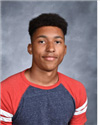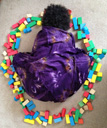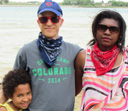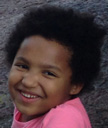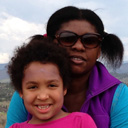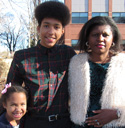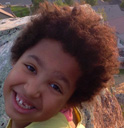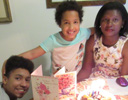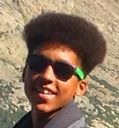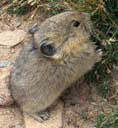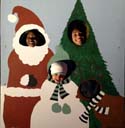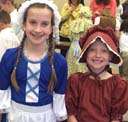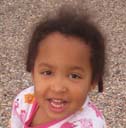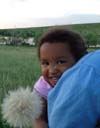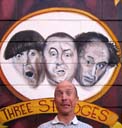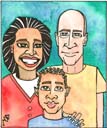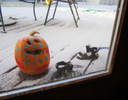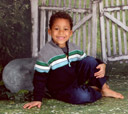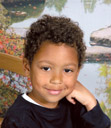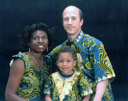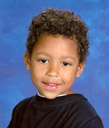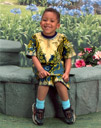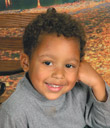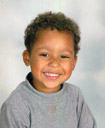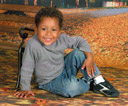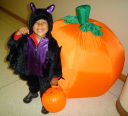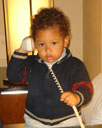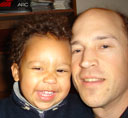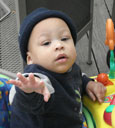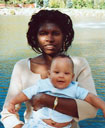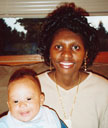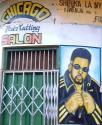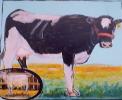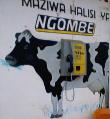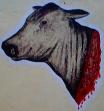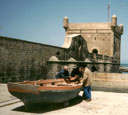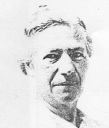1407 photos.
 The Hirchi-Vogl family, Pingree Park
The Hirchi-Vogl family, Pingree ParkCSU Mountain Campus, Colorado, 2009
Mohammed, Latifah, Tariq, Mary, Joanitha, Joachim
 Joanitha and Joachim with saber-tooth tiger, Denver Museum of Nature and Science
Joanitha and Joachim with saber-tooth tiger, Denver Museum of Nature and ScienceDenver, Colorado, 2009
 The Vogl kids on Mary's couch
The Vogl kids on Mary's couchFort Collins, Colorado, 2008
Connor, Kasey, Dylan, Latifah, Tariq, Griffin, Joachim, Cassie
 The Vogls at church on Christmas
The Vogls at church on ChristmasFort Collins, Colorado, 2008
Mary, Tariq, Don, Joachim, Cassie, Dylan, Joanitha, Colette
 Joanitha with Invictus statue
Joanitha with Invictus statueLoveland, Colorado, 2008
Nelson Mandela gave Eddie Daniels a copy of this poem shortly before Eddie was released. Eddie often used it when teaching his students. I am the master of my fate; I am the captain of my soul. Just days after meeting Eddie, we happened upon this statue in Loveland.
 Eddie Daniels with Greg and Joanitha
Eddie Daniels with Greg and JoanithaFort Collins, Colorado, 2008
Eddie Daniels was a prisoner for fighting apartheid in South Africa, along with Nelson Mandela, Walter Sisulu and other future ANC leaders. It was inspiring to meet him and read his book There and Back: Robben Island, 1964-1979.
 Vogl family at Devil's Backbone
Vogl family at Devil's BackboneLoveland, Colorado, 2008
Tricia, Tariq, Mary, Cassie, Jim, Dylan, Joanitha, Joachim
 Krista, Mr. Bakinikana and Joanitha
Krista, Mr. Bakinikana and JoanithaBukoba, Tanzania, 2008
Isaya Bakinikana was the registrar of the University of Bukoba. He is now the principal of the Lutheran teachers' college.
 Joanitha and her grandparents
Joanitha and her grandparents"Kanazi, Kagera", Tanzania, 2008
Her grandparents Kristina and Selestini have a traditional house made of sticks with a thatched roof, and a cement house where they now spend more time. On their farm, they raise matoke (cooking bananas), cassava, chickens and goats. Her grandfather is 84 and still loves to talk and tell stories, but I did not understand his Kiswahili very well.
 senene
seneneBukoba, Tanzania, 2008
Senene (locusts) with legs removed, ready to be deep-fried or smoked and eaten as a snack.
 Vicent Rutatinisibwa and family at Kashenye
Vicent Rutatinisibwa and family at KashenyeBukoba, Tanzania, 2008
driver, Joanitha, Joachim, ?, Vicent, ?, Petronida, ?, ?, Maria, ?, ?, ?
 Joanitha with bird
Joanitha with birdNgorongoro, Tanzania, 2008
One of the birds at our picnic spot was aggressive enough to swoop down and steal part of my sandwich from my hand.
 Joanitha and Joachim with Michael Hodd
Joanitha and Joachim with Michael HoddWindsor, UK, 2008
Michael Hodd was an economics professor at the University of Westminster, and the vice-chancellor of the University of Bukoba from 1999-2000.
 Joachim, Dylan, Cassie, Latifah and Tariq blowing out Greg's birthday candles
Joachim, Dylan, Cassie, Latifah and Tariq blowing out Greg's birthday candlesFort Collins, Colorado, 2008
 Vogl family on Thanskgiving
Vogl family on ThanskgivingFort Collins, Colorado, 2007
Don, Mohammed,Colette, Paul, Tariq, Joachim, Greg, Mary, Latifah, Jim, Dylan, Tricia, Cassie
 The Vogl family
The Vogl familyFort Collins, Colorado, 2006
Don, Tricia, Cassie, Jim, Paul, Dylan, Mohammed, Tariq, Greg, Connor, Mary, Joachim, Griffin, Joanitha, Tom, Mary, Colette, Latifah
 Mary and the seven cousins
Mary and the seven cousinsFort Collins, Colorado, 2006
Connor, Joachim, Griffin, Latifah, Cassie, Dylan, Mary, Tariq
 Jim, Greg, Mary and the kids
Jim, Greg, Mary and the kidsFort Collins, Colorado, 2006
Cassie, Jim, Dylan, Joachim, Greg, Mary, Tariq
 Family and friends at Sprague Lake
Family and friends at Sprague LakeFort Collins, Colorado, 2005
?, ?, Greg, Joanitha, Joachim, Patty, her kids, Colette, Don, Latifah
 Joachim greeting in Vulcan
Joachim greeting in VulcanFort Collins, Colorado, 2005
A Star Trek fan? May you live long and prosper.
 Joachim under lights
Joachim under lightsFort Collins, Colorado, 2005
Working on his tan? Actually these lights were to reduce jaundice.
 Joachim on his 0th birthday
Joachim on his 0th birthdayFort Collins, Colorado, 2005
Joachim Rutasitara Vogl was born in May, 2005. Saint Joachim was the husband of Saint Anne and the father of the Virgin Mary. Joachim is a Jewish name which means 'May Jehovah exalt, God prepares, God will establish, the Lord will judge'. Rutasitara is a Ruhaya name given by Joanitha's father which means roughly 'you will stay out of trouble'.
 Ritters and Vogls at Horsetooth Reservoir
Ritters and Vogls at Horsetooth ReservoirFort Collins, Colorado, 2004
Mike, Jim, Don, Paul, Mohammed, Tricia, Cassie, Dan, Suzy and Mary stand in front of the huge reservoir that holds part of the water supply for Fort Collins and provides scenic walks and boating.
 Joanitha with a moose
Joanitha with a mooseRocky Mountain National Park, Colorado, 2004
We didn't see any moose when we were in the park, but we did see a herd of elk.
 Greg in a valley
Greg in a valleyRocky Mountain National Park, Colorado, 2004
On our way up to the top of the park on Old Fall River Road, we looked back and saw this view of the valley near the Endovalley overlook.
 Greg and Joanitha at Bear Lake
Greg and Joanitha at Bear LakeRocky Mountain National Park, Colorado, 2004
Bear Lake is a beautiful spot and easy to walk around, but we were drenched by a rainfall on our way up to Nymph Lake.
 Greg and Joanitha near a rock tunnel
Greg and Joanitha near a rock tunnelPoudre Canyon, Colorado, 2004
This tunnel was blasted through the rock so the road could follow the canyon.
 Greg and Joanitha in their apartment
Greg and Joanitha in their apartmentFort Collins, Colorado, 2004
In Fort Collins, life in the projects was not so bad.
 Greg and Joanitha with wigs and African shirts
Greg and Joanitha with wigs and African shirtsFort Collins, Colorado, 2004
We love rasta music and saw Lucky Dube's concert in Kampala in 2003, but this is not our real hair.
 old taxi park
old taxi parkKampala, Uganda, 2004
Matatus (minivan commuter taxis) are an important mode of transport within Kampala and elsewhere in Uganda for many people. The legal limit is 14 passengers, plus the conductor and the driver; usually the five rows of benches can seat three people each. In Nairobi the matatus can seat 20; each row has four seats. Getting to your matatu in the maze of vehicles in Old Park can be challenging, and traffic jams can cause long delays.
 bamboo and grass hut
bamboo and grass hut"Kanazi, Kagera", Tanzania, 2004
This traditional Haya hut is built from bamboo poles and covered with grass. Inside the floor is covered with dry grass. In the back is a fireplace; the insides of the roof are black with soot. The compound is home to Joanitha's grandparents and also includes a cement house with tin roof, and a farm which grows mainly matoke (cooking bananas).
 Joanitha buying fish
Joanitha buying fishBukoba, Tanzania, 2004
Fishermen use hand-made wooden boats and hand-woven nets. They sell their catch from the shores of Bukoba. Many catch fish at night by attracting them with kerosene lamps.
 Greg and Joanitha being anointed
Greg and Joanitha being anointedBukoba, Tanzania, 2003
In Bahaya tradition, the wedded couple join feet and are anointed with oil.
 Greg and Joanitha receiving a baby as a wedding gift
Greg and Joanitha receiving a baby as a wedding giftBukoba, Tanzania, 2003
We were treated at the reception with dozens of gifts, but none as surprising as a child.
 Greg and Joanitha seated at wedding reception
Greg and Joanitha seated at wedding receptionBukoba, Tanzania, 2003
The wedding reception was held at the historic Lake Hotel in Bukoba.
 Greg and Joanitha in a jeep
Greg and Joanitha in a jeepBukoba, Tanzania, 2003
After our wedding, we paraded around town in this limousine, sounding triple beeps, cheered on and even followed by many curious townspeople.
 Greg and Joanitha, just married
Greg and Joanitha, just marriedBukoba, Tanzania, 2003
We left the church looking a little stunned at the fanfare of people, vehicles, music and dancing surrounding us.
 Tim, Greg, Joanitha and Donald
Tim, Greg, Joanitha and DonaldBukoba, Tanzania, 2003
Donald passed away suddenly, just a few months after we left East Africa. He was in charge of rebuilding many of the important highways connecting Bukoba to other towns, including Mutukula, the border with Uganda. He was a jovial, witty and intelligent Brit whose wife was originally from Lesotho.
 Greg and Joanitha's wedding
Greg and Joanitha's weddingBukoba, Tanzania, 2003
The wedding took place at Bukoba Roman Catholic Cathedral Parish in central Bukoba on September 13.
 traditional dancer, sendoff party
traditional dancer, sendoff partyBukoba, Tanzania, 2003
This dancing troupe from Mwanza featured a man acting as a crazed monkey.
 traditional music group, sendoff party
traditional music group, sendoff partyBukoba, Tanzania, 2003
This group played music for our wedding send-off ceremony.
 fire dancers, sendoff party, Ntungamo
fire dancers, sendoff party, NtungamoBukoba, Tanzania, 2003
These dancers were skilled with balancing flaming pots on their heads.
 Greg and Jovita
Greg and JovitaBukoba, Tanzania, 2003
Mr. Jovita, a friend of Joanitha's father, served as my father for the sendoff and gave me away at the wedding.
 sendoff delegation, Ntungamo Seminary
sendoff delegation, Ntungamo SeminaryBukoba, Tanzania, 2003
Sawiya Abubakar, Fidelis Nyegila, Mr. Jovita, Samuel Mutasa, Johanitha Mwijage, 3 others
 Joanitha's mother at mama kikapu party
Joanitha's mother at mama kikapu partyBukoba, Tanzania, 2003
At this ceremony the family received gifts in honour of Joanitha's wedding.
 bridge across the Kanoni river
bridge across the Kanoni riverBukoba, Tanzania, 2003
I crossed this bridge many times going to and from Joanitha's house in Buyekera. It can be difficult to see at night unless the moon is out because much of the path is unlit.
 MV Victoria
MV VictoriaBukoba, Tanzania, 2003
This ferry goes to and from Mwanza three times a week. A similar ferry, the MV Bukoba, sank in an accident near Mwanza in 1996, and hundreds of passengers were drowned.
 Greg
GregKampala, Uganda, 2003
Greg relaxing in front of the apartment on the hill in Nsambya where we lived for a year. It was a very dusty place with plumbing problems, but it was securely fenced in and our flowers grew like crazy. It was a 15-minute walk down the hill to Kabalagala and Kampala International University.
 Mbarara University of Science and Technology
Mbarara University of Science and TechnologyMbarara, Uganda, 2003
Teachers from the Faculty of Science at Uganda Martyrs University went to Mbarara for a retreat and to visit MUST.
 second-year computer science students, Uganda Martyrs University
second-year computer science students, Uganda Martyrs UniversityNkozi, Uganda, 2003
Caroline, Natacha, Sandrine, Arlene, Donavine, Betrix, Maureen, Doreen, Florence, Patricia, Alice, Agnes, Guy, Herve, Armel, Elvis, Arthur, Ivan, Jerome, Charles, James, Herve, Christian, Thomas
 Joanitha in a tree, national arboretum
Joanitha in a tree, national arboretumNairobi, Kenya, 2003
The arboretum in Kenya is a large park full of many varieties of trees, both indigenous and imported.
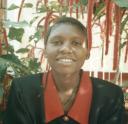 Joanitha on Valentine's day
Joanitha on Valentine's dayKampala, Uganda, 2003
The flowers and outdoor setting at this hilltop hotel in Kabalagala made up for the food and rooms.
 Joanitha near Kampala International University
Joanitha near Kampala International UniversityKampala, Uganda, 2003
Joanitha attended KIU for a year in computer science but was disappointed by the chaotic disorganization of the newly founded university and found the classes to be overcrowded, impersonal and nonpractical.
 Joanitha preparing senene
Joanitha preparing seneneKampala, Uganda, 2003
Senene are bright green grasshoppers which appear at a few short times of the year in the Great Lakes region of East Africa. They are attracted by artificial lights, captured in bedsheets, and fried in oil or slowly roasted over coals. They make a spicy, crunchy snack and are traditionally associated with couples in love.
 Joanitha at a photo studio
Joanitha at a photo studioKampala, Uganda, 2003
We came to a small, crowded shop in the middle of town to have some ID photos taken, but they were taking so long that we decided to use their studio and my camera.
 inside Kasubi tombs
inside Kasubi tombsKampala, Uganda, 2003
Inside the main building are spears, shields, medals, portraits, a canon from Henry Morton Stanley, chairs from Queen Elizabeth I, and a stuffed leopard.
 Kasubi tombs
Kasubi tombsKampala, Uganda, 2003
This building holds artifacts of the four previous kings of Buganda.
 Rubaga Cathedral
Rubaga CathedralKampala, Uganda, 2003
I saw this Roman Catholic cathedral every week on my way to and from Uganda Martyrs University because they have a Rubaga campus where the bus departs for Nkozi. It has a large interior and nice pipe organ.
 Joanitha photographing monkeys, national arboretum
Joanitha photographing monkeys, national arboretumEntebbe, Uganda, 2003
The arboretum in Entebbe has a nice setting by Lake Victoria near the Wildlife Education Centre and is home to two types of monkeys and many types of birds.
 breadfruit
breadfruitEntebbe, Uganda, 2003
The breadfruit or jackfruit is found in East Africa as well as Asia.
 shoebill stork
shoebill storkEntebbe, Uganda, 2003
The shoebill stork is a rare bird of East Africa, one of the many animals found in natural settings at the Entebbe Wildlife Education Centre.
 two crested cranes, Entebbe Wildlife Education Centre
two crested cranes, Entebbe Wildlife Education CentreEntebbe, Uganda, 2003
The crested crane is the national bird of Uganda and is often found in pairs in wetland areas.
 Joanitha and two hatted characters, Speke Resort
Joanitha and two hatted characters, Speke ResortMunyonyo, Uganda, 2003
These two contestants in the hat contest at the goat races were like right out of My Fair Lady. Joanitha wanted to stay late; she could have danced all night.
 goat races, Speke Resort
goat races, Speke ResortMunyonyo, Uganda, 2003
Goats are not exactly born racers. They are followed closely from behind with a large banner, and run more or less neck and neck the whole way around. The winner is the one who happened to be a little more nervous than the others at the approach of the finish line. But it's a great excuse for food, drink and socializing.
 Greg and Joanitha in the rain
Greg and Joanitha in the rainMount Elgon, Uganda, 2003
Mount Elgon was cold and rainy, and climbing muddy paths was a challenge, but we enjoyed the lush vegetation and serenity.
 Joanitha with flowers
Joanitha with flowersMount Elgon, Uganda, 2003
Mount Elgon has a beautiful variety of flowering plants.
 Joanitha with armed park ranger
Joanitha with armed park rangerMount Elgon, Uganda, 2003
To take a walk in Mount Elgon, even for day hikes, you are required to be accompanied by armed park rangers, who protect against poachers and bandits as well as whatever few rare wild animals might remain. But the ranger said the park has been quite safe lately.
 Don Vogl and artwork
Don Vogl and artworkSouth Bend, Indiana, 2003
My father, Don Vogl, is an accomplished artist and retired University of Notre Dame art professor. When he left South Bend for Colorado in 2003 his farewell show was covered in the South Bend Tribune. See his web site at <a href=http://donvogl.com/>donvogl.com</a>.
 851 Park Avenue
851 Park AvenueSouth Bend, Indiana, 2003
My parents lived in this house from 1970 until 2003 when they retired to Colorado. I spent most of my childhood here, and it is the only place I consider my home.
 BDC workshop participants
BDC workshop participantsBukoba, Tanzania, 2002
Greg trained over 50 participants at the Bukoba District Council in Windows, Word, Excel and Access.
 rock paintings, Bwanjai caves
rock paintings, Bwanjai cavesKagera, Tanzania, 2002
The Computers for Africa team and some University of Bukoba staff including Joanitha visited the Bwanjai rock paintings, which are hundreds of years old, but have been damaged by more recent graffiti.
 Mugeza school for the deaf
Mugeza school for the deafNyakato, Tanzania, 2002
The Computers for Africa team visited and donated a computer to Mugeza school for the deaf.
 computer networking workshop participants, Ihungo Secondary School
computer networking workshop participants, Ihungo Secondary SchoolBukoba, Tanzania, 2002
In December 2002, 35 people participated in a computer networking workshop at Ihungo Secondary School.
 networking workshop participants, Ihungo Secondary School
networking workshop participants, Ihungo Secondary SchoolBukoba, Tanzania, 2002
Four participants are engaged with learning the fundamentals of computer networking.
 computer laboratory, Ihungo Secondary School
computer laboratory, Ihungo Secondary SchoolBukoba, Tanzania, 2002
Greg, Tony and Laurence facilitated a networking workshop in the new Ihungo computer lab.
 Miss Kagera beauty pageant
Miss Kagera beauty pageantBukoba, Tanzania, 2002
This beauty pageant was quite a show, with music, dancing, food and drink, talent performances and beautiful costumes.
 picnic overlooking Lake Victoria
picnic overlooking Lake VictoriaBukoba, Tanzania, 2002
The center of Bukoba is fairly flat, but the surrounding hills give beautiful views of the lake below.
 airstrip
airstripBukoba, Tanzania, 2002
The Bukoba airport is scenically located near the lake; planes pass over Musira Island. The airstrip is not paved, and the big number 13 and a carcass of a crashed plane are not very reassuring.
 Lake Victoria
Lake VictoriaBukoba, Tanzania, 2002
Bukoba has a nice sandy beach and scenic views of Lake Victoria. The concrete structure in the foreground is the 100-year-old remnant of a German communication tower. Musira island can be seen in the distance.
 The University of Bukoba
The University of BukobaBukoba, Tanzania, 2002
From July 2001 until late 2003 the University of Bukoba was housed in the former immigration building on Ghana Road, behind the Regional Offices. The main entrance is on the right. The blue door to the left was the entrance to the computer lab.
 front view of Kyanyi campus, University of Bukoba
front view of Kyanyi campus, University of BukobaBukoba, Tanzania, 2002
A renovated wing of the Kyanyi campus and the university vehicle. Due to a lack of funds, renovations were only partly completed in 2002 before work came to a standstill.
 aerial view of Kyanyi campus, University of Bukoba
aerial view of Kyanyi campus, University of BukobaBukoba, Tanzania, 2002
View of the Kyanyi campus from behind, showing two renovated buildings and a scenic overlook of Bukoba.
 Lake Hotel
Lake HotelBukoba, Tanzania, 2002
Like many of Bukoba's historic landmarks, the Lake Hotel is in a state of decay.
 Greg facilitating a network workshop, Ihungo Secondary School
Greg facilitating a network workshop, Ihungo Secondary SchoolBukoba, Tanzania, 2002
Ihungo Secondary School was kind enough to allow us to use their newly acquired computers to present a workshop in computer networking. In exchange, we helped install and configure the network.
 Computers for Africa team
Computers for Africa teamBukoba, Tanzania, 2002
A team of nine students and two teachers from Balerno High School, Edinburgh, Scotland came to Bukoba in 2002 to donate 30 computers to 13 local organisations including the University of Bukoba, and Ihungo, Hekima and Rugambwa Secondary Schools.
 Joanitha descending to Karobera Beach
Joanitha descending to Karobera BeachBukoba, Tanzania, 2002
We visited the small, sandy, picturesque beach below. It was a long 10 km hike back into town.
 Bas and Matt, Humura Secondary School
Bas and Matt, Humura Secondary SchoolRubya, Tanzania, 2002
Bas and Matt were two VSO volunteers at a rural secondary school. Matt's website is <a href='http://www.karibu-rubya.net/'>http://www.karibu-rubya.net/</a>.
 Joanitha viewing Falcon bus
Joanitha viewing Falcon busKagera, Tanzania, 2002
Our bus was stuck in the mud for over an hour, precariously close to falling into a ditch.
 UConn visits Kyanyi campus, University of Bukoba
UConn visits Kyanyi campus, University of BukobaBukoba, Tanzania, 2001
In June 2001 some staff of the University of Connecticut visited the University of Bukoba Kyanyi campus.
 RAS workshop participants, University of Bukoba
RAS workshop participants, University of BukobaBukoba, Tanzania, 2001
Kwitega, Kissimba, Maagi, Mulogo, Masuruli, Muhabuki: Greg's first six computer workshop participants at the University of Bukoba building on Ghana Road.
 information technology students, University of Bukoba
information technology students, University of BukobaBukoba, Tanzania, 2001
Dawooda, Amin, Jollystar, Alex, Rumanyika, Thomas, Justin, Salum, Joanitha, Aneth, Leserian, Rosemary, Rahely, Edina, Martha, Janat
 Greg and Deqa at 'Miami Beach'
Greg and Deqa at 'Miami Beach'Bukoba, Tanzania, 2001
Marialena guided us through a fishing village just outside Bukoba to this pretty spot on the beach where we sat and talked.
 my house on Arusha Street
my house on Arusha StreetBukoba, Tanzania, 2001
I live just a block from the main market, and you can see the spire of the Catholic cathedral in the background. Also note the papaya tree, the tin roof, iron fence and thick vegetation.
 Nyumba ya Vijana
Nyumba ya VijanaBukoba, Tanzania, 2001
The University of Bukoba was located at the Nyumba ya Vijana (Bukoba Youth Centre) for two academic years until June 2001.
 Joanitha on the phone at the University of Bukoba
Joanitha on the phone at the University of BukobaBukoba, Tanzania, 2001
Joanitha served as secretary and personal assistant to the Registrar for over three years and provided important administrative support to the fledgling University.
 Joanitha with Johanitha and Sawiya
Joanitha with Johanitha and SawiyaBukoba, Tanzania, 2001
This picture may have been at the reception for my arrival in Bukoba on April 2.
 church altar, Bujora Sukuma Museum
church altar, Bujora Sukuma MuseumMwanza, Tanzania, 2001
The altar is designed like a Sukuma chief stool to emphasize its importance.
 CCT Bishop Kisanji Women's Training Centre
CCT Bishop Kisanji Women's Training CentreMorogoro, Tanzania, 2001
VSO volunteers were given use of this centre as a place to be trained in Tanzanian culture, the Swahili language, health and administrative matters.
 poster about circumcision
poster about circumcisionMorogoro, Tanzania, 2001
wanawake wana haki kukataa kutahiriwa - women have the right to refuse circumcision
 the Vogl family at Christmas
the Vogl family at ChristmasSouth Bend, Indiana, 1999
Front row: Tom, Mary, Connor, Colette, Emmanuel, Greg. Back row: Mohammed, Joe, Don, Becky, Paul
 Greg, Mary and Emmanuel inner-tubing
Greg, Mary and Emmanuel inner-tubingSouth Bend, Indiana, 1999
Emmanuel had his first experience with snow in Indiana. He seemed not to mind the cold.
 Greg and Emmanuel Edomwande
Greg and Emmanuel EdomwandeSouth Bend, Indiana, 1999
Emmanuel and I taught at Ponhofi Senior Secondary School in Namibia for three years and shared a teacher hostel for a year. Emmanuel came to the US in 1999 and visited me and my family for Christmas. He recently completed his PhD in entomology and is living in Texas.
 Joanitha in academic gown
Joanitha in academic gownBukoba, Tanzania, 1999
studio portrait. University of Bukoba students were issued academic gowns when the university opened.
 Joanitha and friends carrying buckets
Joanitha and friends carrying bucketsBukoba, Tanzania, 1998
Only a small minority of African families get their water from a faucet in their homes. Many African women and girls must carry buckets of water on their heads for long distances so that their families can drink water, cook and wash clothes.
 Joanitha's shop
Joanitha's shopBukoba, Tanzania, 1998
After Sumve, Joanitha tried to start a shop, but it never really took off.
 the Vogl family at Christmas dinner
the Vogl family at Christmas dinnerSouth Bend, Indiana, 1997
Clockwise from upper left: Mary, Mohammed, Jim, Don, Colette, Paul, Suzy, Tom, Gertrude, Dawn,
 Joanitha near a tree planted by President Moi
Joanitha near a tree planted by President MoiKisumu, Kenya, 1997
Joanitha's school went on a sporting trip to Kenya and stopped by this monument to Kenya's long-time president. Many things were named after Moi, who held onto power for more than 20 years.
 Joanitha acting as a ghost
Joanitha acting as a ghostMwanza, Tanzania, 1997
Joanitha enjoyed drama and acting. Some students were afraid of her for some time after this performance.
 teacher-student basketball game, Ponhofi Senior Secondary School
teacher-student basketball game, Ponhofi Senior Secondary SchoolOhangwena, Namibia, 1997
This was my field of dreams. After three years of playing basketball on the unsurfaced, dusty netball court, with no nets or backboards and tiny rims, we finally found funding for a real basketball court. Playing in the teacher-student game at the end of the year was a dream come true. The girls picked up the game with amazing speed, probably because they could transfer the skills they knew from netball, a similar sport. The court was an expensive development project and hastened the inevitable Americanisation of the world, but it would be nice if every school in the North could have one. On the right is an enormous omukwiyu (wild fig) tree, good for shade and a popular hangout for kids and goats.
 staff, Ponhofi Senior Secondary School
staff, Ponhofi Senior Secondary SchoolOhangwena, Namibia, 1997
Greg Vogl (me), physics and computer teacher, USA, Monika Katanga, secretary, Namibia, Tuyeni Ndaikile, Kwanyama teacher, Namibia, Martha (Katiti) Nhinda, Kwanyama teacher, Namibia, Irene Carolissen, English teacher, Namibia, Saima Amunyela, Kwanyama teacher, Namibia, Lydia (Ivawa) Munghadi, biology teacher, Namibia, Liam Garvey, mathematics teacher, Australia, Julie Murphy, accounting teacher, Scotland, Philip Shimhanda, natural economy teacher, Namibia, Emmanuel Edomwande (seated), biology teacher, Nigeria, Eric Kemanya, English teacher, Namibia, Mark Fleming, mathematics teacher, Scotland, Mary (Maria) Nashandi, business studies teacher, Namibia, Peter Maswahu, agriculture teacher, Namibia, Lucky (Nhlanhla) Lupahla, mathematics teacher, Zimbabwe, Michael Kavungo, Vice-Principal and English teacher, Namibia, Håkon Hermanstrand, English teacher, Norway
 House 19, Ponhofi School
House 19, Ponhofi SchoolOhangwena, Namibia, 1997
I lived in this house with a Nigerian entomologist. There were plenty of insects for him to study.
 House 16, Ponhofi School
House 16, Ponhofi SchoolOhangwena, Namibia, 1997
I stayed in this house in late 1995 with Liam Garvey from Australia.
 Red, white and blue tin house
Red, white and blue tin houseOhangwena, Namibia, 1997
I passed this abandoned shack in the middle of an empty lot whenever going into town. I took this photo the morning I left Ohangwena. Elago Elago writes: As it's painted in DTA colours, I suspect it's an abandoned DTA cardboard type pre-fabricated office. The DTA had quite many of those (and mobile ones) in the 4 northern regions and after losing quite a lot of support, they simply abandoned what they couldn't take along.
 road, Etosha National Park
road, Etosha National ParkOkaukuejo, Namibia, 1997
A dirt road, a tree, some bushes, some rainclouds; an ordinary African scene that is indescribably compelling.
 two zebra, Etosha National Park
two zebra, Etosha National ParkOkaukuejo, Namibia, 1997
Etosha is the focal point of Namibia for most tourists. It contains an enormous number and variety of animals, but the subtle beauty of the plants and setting might be overlooked.
 upside down trees, Etosha National Park
upside down trees, Etosha National ParkOkaukuejo, Namibia, 1997
San legends say that when God threw these trees in anger, they landed upside down, with the roots in the air. These trees have been damaged by elephants, and many are now protected by a fence.
 stub of a tree, Etosha National Park
stub of a tree, Etosha National ParkHalali, Namibia, 1997
Etosha contains a variety of strangely shaped trees such as this.
 tree and Okaukuejo tower, Etosha National Park
tree and Okaukuejo tower, Etosha National ParkOkaukuejo, Namibia, 1997
This type of tree (camelthorn? acacia?) is very common throughout the Namibian savanna.
 tree and valley
tree and valleyBrandberg, Namibia, 1997
This scene reminds me of the Biblical story of Moses and the Burning Bush. Brandberg means Fire Mountain; from a distance the mountain appears red as if it were on fire. The Brandberg is the tallest mountain in Namibia. The summit is less than 3000 metres, but it is a challenge to climb because of the heat and amount of drinking water you must carry.
 donkey cart
donkey cartSpitzkoppe, Namibia, 1997
Donkey carts are still used in rural areas of Namibia and sometimes even in larger villages like Oshakati.
 sociable weaver nest
sociable weaver nestUis Myn, Namibia, 1997
These enormous nests can be seen in trees throughout Namibia. They can be inhabited by hundreds of little birds, and the nests can take over and destroy the whole tree.
 melons
melonsSossusvlei, Namibia, 1997
Finding these melons in the middle of the desert was a delightful surprise. Desert melons are a popular source of food for the Nama people of the center and south.
 Sossusvlei Pan
Sossusvlei PanSossusvlei, Namibia, 1997
The Sossusvlei pan is nestled among the world's tallest sand dunes in the southwest. It only fills with water for a few weeks about once every ten years; otherwise it is dry. For those few weeks the desert miraculously becomes green.
 aloe and quiver tree, Kokerboomwoud
aloe and quiver tree, KokerboomwoudKeetmanshoop, Namibia, 1997
Aloes are very common, especially in the South. There are hundreds of varieties.
 quiver tree, Kokerboomwoud
quiver tree, KokerboomwoudKeetmanshoop, Namibia, 1997
The Quiver Tree is so named because San (so-called Bushmen) hunters hollow out the branches to make quivers for storing their arrows. The trees do not quiver much in the wind.
 bicycle and mural
bicycle and muralSwakopmund, Namibia, 1997
This bicycle nicely matches the mural behind it. Perhaps the artist is the bicyclist.
 Mural
MuralWindhoek, Namibia, 1997
This mural shows themes of hope in the end of the 1980s war for independence and the new government.
 Christus Kirche
Christus KircheWindhoek, Namibia, 1997
This German Lutheran church is a landmark overlooking Windhoek.
 Tintenpalast
TintenpalastWindhoek, Namibia, 1997
This 'ink palace' is the Namibian house of parliament and opened in 1913.
 Windhoek High School students lined up for assembly
Windhoek High School students lined up for assemblyWindhoek, Namibia, 1997
Windhoek High School students were professionally dressed and neatly lined up for morning assembly.
 red tree
red treeElmina, Ghana, 1997
This tree has two 'arms' that look like they could grab you. I would definitely not walk by this tree at night, especially after listening to African folk tales about witches.
 fishing boats
fishing boatsElmina, Ghana, 1997
The coast of West Africa is bustling with business, such as fishing, shipping, petroleum and tourism. Hand-made nets and boats compete with more modern equipment.
 drawbridge
drawbridgeElmina, Ghana, 1997
This is an entrance to the Cape Coast Castle, one of several castles built by the Portuguese around 1500 and used for the slave trade for centuries by various European colonizers. There are several well-preserved slave castles on the coast of Ghana.
 dungeon door
dungeon doorElmina, Ghana, 1997
This is the door to a dungeon where hundreds of Africans were chained in small, dark, cave-like cells until they could be packed into boats and sent to the Americas. Those who escaped disease, starvation and fatal beatings and were free of physical weaknesses became slaves in the New World. Those who did not were tossed in the ocean and fed to the sharks. The museum, which was once the church, is a must-see.
 dancers
dancersKpalime, Togo, 1997
This fête du récolte (harvest festival) included a variety of people, colourful costumes, and lively music and dancing.
 mosque
mosqueBobo Dioulasso, Burkina Faso, 1996
West Africa has a long history of Islamic influence, especially near the Sahara desert. This mosque is over a hundred years old, yet it is built primarily of mud. It is much smaller than the famous ones in Mali.
 blacksmith's chamber
blacksmith's chamberBobo Dioulasso, Burkina Faso, 1996
The traditional blacksmith is still needed in the rural areas, though the tools are gradually modernizing.
 storage area
storage areaBobo Dioulasso, Burkina Faso, 1996
Houses in Burkina Faso are built of mud, stone or straw. This mud village was relatively traditional, and there were many locations for sacrificing animals. To get to this village, I rode on the back of a small motorcycle. I also toured a stone village on a hill and a pond with giant sacred catfish.
 Pont de Lianes (vine bridge)
Pont de Lianes (vine bridge)Man, Cote D'Ivoire, 1996
Near the border between Cote d'Ivoire and Guinea, the Dan people still construct bridges out of vines. The bridges appear overnight, so that nobody knows exactly who constructed or hung them.
 tree trunk
tree trunkMan, Cote D'Ivoire, 1996
Varieties of these trees grow to enormous heights. The roots of this tree do not go very deep because the soil of tropical forests is relatively thin. Ribs in the trunk support the tree like the buttresses of a cathedral. The tropical forests in Cote d'Ivoire have mostly been cleared, and I saw truckloads of huge logs, but Gabon is one country that still has large reserves of tropical forest.
 twisted tree
twisted treeMan, Cote D'Ivoire, 1996
Many trees take on a monstrous, grotesque appearance, twisted by some unknown combination of wind, weather, animals, people and spirits.
 women carrying bundles of thatch (grass)
women carrying bundles of thatch (grass)Oshikango, Namibia, 1996
The Owambo people of the region have adopted western dress, influenced by missionaries who arrived about a century ago. Women in Namibia, as in other countries of Africa, do most of the physical labour on farms. In the background is the Oshikango border post. There is a large amount of trade near the Angolan border, especially since the end of the Angolan civil war in 1994. The women may have brought the thatch from Angola, which is less densely populated and less deforested. The thatch is sold at markets and used for roofing.
 oshana
oshanaEngela, Namibia, 1996
The northern part of Namibia is flat and becomes wetter as you go north and east. The rainy season lasts roughly from December to April, and oshanas (seasonal lakes) fill, flowing slowly southward from Angola toward the Etosha pan, where it provides water for the wildlife in Etosha National Park. The roads become muddy and difficult to navigate. Still, the rain is sporadic and unpredictable, and drought affects crops.
 child outside a tin house
child outside a tin houseOniipa, Namibia, 1995
Because of the recent population boom, deforestation has limited the amount of available wood (mostly from omusati/mopane trees) for fencing and housing. As a result, a more Western style of housing has been adopted: rectangular houses made of metal or concrete, with wire mesh for fencing. These houses are hotter and costlier, but they are more permanent, they save wood, and their modernity makes them a status symbol. A volunteer teacher I knew lived in a traditional compound in a hut with walls made of cement interspersed with hundreds of empty dumpies (beer bottles) to act as tiny windows of light. Another volunteer helped to stock a dumpie library with books. Tin buildings are very commonly seen on roadsides, often serving as bottle stores (bars).
 Class 11C, Ponhofi School
Class 11C, Ponhofi SchoolOhangwena, Namibia, 1995
Most of the girls were in the required uniform most of the time, but the boys preferred to pretend to be rebels. In many schools, students cannot afford to buy a uniform, but at Ponhofi this was mostly a false excuse. The students were generally friendly, polite and well-behaved. They tried incredibly hard, despite their limited exposure to English, so although the teachers did not enforce discipline well, they usually did not have to. Most students came from rural farms, yet they hoped to get a job in a town or city, where the competition for white-collar jobs is stiff.
 100-yard dash on the football (soccer) field, Ponhofi School
100-yard dash on the football (soccer) field, Ponhofi SchoolOhangwena, Namibia, 1995
Sport and recreation facilities are very limited in rural areas in the North. Sports shoes and uniforms are luxuries that few schools or students can afford. Also, it must be difficult to be an athlete considering the low amount of calories in the diet provided by the hostel cafeteria. Yet some of the boys appeared to have great potential. Sports for girls are not considered very important.
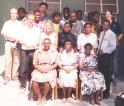 staff, Ponhofi Senior Secondary School
staff, Ponhofi Senior Secondary SchoolOhangwena, Namibia, 1995
The teachers and staff at Ponhofi were a great team and fun to work with. They were a culturally and linguistically diverse group. Ponhofi had more volunteers than most schools and was relatively overstaffed (average teacher class load was *only* 25 to 30 hours per week out of 40, and average class size was about 35). The cities and relatively nice schools like Ponhofi attract the best teachers and students, so there is a very unequal distribution of talent.
 mural
muralWindhoek, Namibia, 1995
Murals are a popular form of art in urban Namibia and South Africa, especially around the time of independence and the end of Apartheid. This mural represents the diversity of Namibia's flora and fauna.
 mine field
mine fieldOhangwena, Namibia, 1995
I passed this mine field every time I walked from the dining hall to the post office. Large armored trucks would drive through the mine fields and set off mines around lunch time. The border between Namibia and Angola remains fairly heavily mined, and many people, especially children, continue to be killed or injured by mines long after the end of the war. Children think the mines are toys and pick them up. An education and de-mining campaign has helped somewhat, but it is much more expensive to de-mine than to mine. The US continues to be one of the few countries that refuses to sign the international treaty banning land mines.
 souvenirs on Post Street Mall
souvenirs on Post Street MallWindhoek, Namibia, 1995
Souvenirs for sale include baskets, wood bowls and animal carvings, necklaces, and drums, most of which are made in the North. Downtown in the capital city is very similar to a European city: modern, clean, and many rich people. When you go to the suburbs you see the poor people in small houses crammed into dusty lots. During the Apartheid era, non-whites were driven into the suburbs, and though the law has changed, the inequalities are slow to go away.
 fence and shelter inside a traditional homestead
fence and shelter inside a traditional homesteadOniipa, Namibia, 1995
A traditional Owambo homestead was a large maze of wooden fences surrounding a group of round wood huts with thatched roofs and sand floors, each of which served a different purpose (bedrooms, grain storage, kitchen, social quarters, etc.) Wealthier farmers now own cars or bakkies (pickup trucks).
 my first house, Ponhofi School
my first house, Ponhofi SchoolOhangwena, Namibia, 1995
I shared this house with Adams Kamulegeya, a Ugandan maths teacher I later met by chance in Mutukula in 2003, his Owambo wife Letu, their newborn baby, and some chickens (who had the biggest room). It was a modern concrete house with a metal roof, and electricity and running water (most of the time).
 goat
goatOhangwena, Namibia, 1995
This goat was slaughtered for a party held by a British volunteer. Goats and cows are a common source of meat in the North, and goat meat tastes good when properly seasoned and cooked.
 ferry
ferryZanzibar, Tanzania, 1995
We took a ferry like this to get to the island. It only took about an hour, but it cost about as much as a three-day train trip to Zambia.
 columns
columnsZanzibar, Tanzania, 1995
The influence of the highly advanced Swahili culture has extended up and down the coast of East Africa for several centuries. They traded with people of distant lands, sailing on the Indian Ocean in dhows.
 door, Zanzibar Town
door, Zanzibar TownZanzibar, Tanzania, 1995
Zanzibar town is a picturesque Islamic city with narrow streets, ornately carved doorways, and centuries-old buildings which are being restored. It is becoming a major tourist destination in Africa.
 mosque entrance, Zanzibar Town
mosque entrance, Zanzibar TownZanzibar, Tanzania, 1995
The Swahili people are Muslims; their language is a mix of Arabic and Bantu languages, and can be written in either Arabic or Western characters. Millions of people from several countries in east and central Africa speak Swahili.
 National Museum, Zanzibar Town
National Museum, Zanzibar TownZanzibar, Tanzania, 1995
The Zanzibar National Museum includes many fascinating items from the Swahili and colonial eras.
 cow and hut
cow and hutZanzibar, Tanzania, 1995
The island's main industries are tourism and agriculture. Many kinds of spices are grown on the island for exporting.
 tortoise, Prison Island
tortoise, Prison IslandZanzibar, Tanzania, 1995
Prison Island is a short boat trip from Zanzibar town. There we saw the ruins of the prison, swam and snorkeled above the coral reefs. It is easy to find these large tortoises on the island. They move very slowly; the big ones must weigh over 200 kg.
 sycamore fig tree
sycamore fig treeOndangwa, Namibia, 1995
The north has some very large trees that provide shade even in the dry season. In the rainy season, this tree is surrounded by water.
 Makalani palm tree
Makalani palm treeOhangwena, Namibia, 1995
As you drive north towards Ondangwa, you are suddenly surprised by the appearance of these tall trees, which are an indicator of a relatively wet rainy season and of large underground water reserves. Ovambos use every part of the tree, which they call omulunga, e.g. the trunk for stools and cattle troughs, fronds for weaving baskets, eendunga (palm nut fruits) for food and oil, and sap for producing palm wine. Wood of other trees is used for housing, fencing, firewood, furniture, cups, bowls, buckets, fish traps, handles and weapons.
 flamboyant tree
flamboyant treeMorogoro, Tanzania, 1995
The red buds of Flamboyant trees are a common sight in southern Africa and add colour to the surroundings.
 tree roots, Changuu (Prison) Island
tree roots, Changuu (Prison) IslandZanzibar, Tanzania, 1995
For me, this picture symbolizes the idea that African roots run deep. Once you live there, you cannot forget your memories and responsibility to your friends and family there. You know that one day you will return. (Changuu Island used to be a prison; now it is inhabited by snorkelling tourists and giant tortoises.)
 spiraling palm tree
spiraling palm treeZanzibar, Tanzania, 1995
Compared with those in Namibia, the trunks of palm trees on Zanzibar island are very tall and thin. The wind may have caused this tree to grow in a corkscrew shape.
 baobab tree
baobab treeVictoria Falls, Zimbabwe, 1995
Baobab trees are common throughout Africa and can be found in the northern part of Namibia, where they are known as omukwa. They can live for hundreds of years. This one is very old and has a trunk of about 10 metres across. The San use many parts of these trees.
 view of Auas Mountains from Harmony Centre
view of Auas Mountains from Harmony CentreWindhoek, Namibia, 1994
This photo was taken from my Peace Corps training site. It represents my first view of Namibia: hot, dry and dusty, short shrub-like trees with thorns and few leaves, savannah and mountains of the central region, and beautiful rainbows and sunsets. When we volunteers arrived in November it was said that we brought the rain. Rain is considered good weather. Windhoek, the capital city, is in a semi-desert region, and water shortages become a major problem during droughts. Water must be piped from dams and rivers as far as several hundred kilometres away to meet the growing water needs of the city.
 King Hassan II and his two sons
King Hassan II and his two sonsFès, Morocco, 1992
In 1999, King Hassan II died and was succeeded by his eldest son, Sidi Mohammed, who became King Mohammed VI. His other son is Moulay Rachid.
 Tom and Don with their catch
Tom and Don with their catchMinocqua, Wisconsin, 1990
As kids we used to fish for perch, bluegill, sunfish and rock bass with worms. As we grew up, we cast lures for bigger fish like smallmouth and largemouth bass and northern pike (though these are really too small). On rare occasions we caught walleye and muskellunge.
 Grandma Vogl and other relatives
Grandma Vogl and other relativesMinocqua, Wisconsin, 1990
Seated: Carol, Colette, Anna. Standing: Dick, Tom, Don, Jim, Mary, Mohammed.
 David in high school
David in high schoolSouth Bend, Indiana, 1983
studio portrait. My friend David loved games and comic books and had a great sense of humor.
 Will in high school
Will in high schoolSouth Bend, Indiana, 1983
studio portrait. My friend Will was smart and open-minded and greatly influenced my intellectual growth.
 Ralph in high school
Ralph in high schoolSouth Bend, Indiana, 1983
studio portrait. My friend Ralph loved cars and travel adventures.
 Don in high school
Don in high schoolSouth Bend, Indiana, 1983
studio portrait. My friend Don was a down-to-earth, laid back, poetic hippie.
 Paula in high school
Paula in high schoolSouth Bend, Indiana, 1983
studio portrait. My friend Paula was fun-loving and always laughing.
 Kathy in high school
Kathy in high schoolSouth Bend, Indiana, 1983
studio portrait. My friend Kathy was a writer and good citizen.
 Stanley Clark graduation awards
Stanley Clark graduation awardsSouth Bend, Indiana, 1980
Jon, Camille, Beanie, Greg (valedictorian), Carl, Paul, Bob, David
 The Ritter family
The Ritter familyLacrosse, Wisconsin, 1955?
John Helton, Roseann, Colette, Leonard Ritter (my grandfather), Elizabeth Udulusch (my grandmother)
 Michael Vogl with baby
Michael Vogl with babyMilwaukee, Wisconsin, 1955?
Michael Vogl was my grandfather. The baby might be my cousin Danny.
 The Reinke family
The Reinke family, Wisconsin, 1930
Martha, Louis Lieberfinger, Don, Michael, Emelie, Lena? Clara?, Frank, ?, ?. seated: Amanda, Jerry, Charles Eggert, Anne, Norbert, Dorothy, Junior, ?, Robert, ?, Charlotte Eggert?
 The Reinke family
The Reinke family, Wisconsin, 1923
Anne, Amanda, George, Rose, Edward, Emelie, Mary, Frank. seated: Martha, Clara
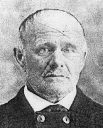 Frank Reinke
Frank Reinke, Wisconsin, 1918
Frank Reinke was my great grandfather. Frank Frederick was the fourth child of Franz Reinke and Caroline Holke. He married Emilie Stischke. They had ten children: Martha, Maria, Amalia, Amanda, Alma, Rosa, George, Anna, Clara Ann and Edward. This photo was taken from his alien registration card in 1918.
 Teodor Udulusch
Teodor UduluschOggau, Austria, 1890?
Teodor Udulusch (1865-1914), my great grandfather, migrated to Sparta, Wisconsin in 1892 with his wife Maria and three children.
 Maria Magdalene Miehl
Maria Magdalene MiehlOggau, Austria, 1890?
Maria Magdalene Miehl (1871-1961), my great grandmother, was born in Kroisbach, Hungary, the youngest of 10 children, orphaned at age 8, married Teodor Udulusch in 1889 in Oggau, Austria, came to Wisconsin in 1892, and had 12 children.
 Emelie Stischke
Emelie Stischke, Wisconsin, 1886
Emilie Stische was my great great grandmother. She was the daughter of Louis Stischke and Rosa Lucht. She was born in Germany and came to the USA with her mother and other family members.























